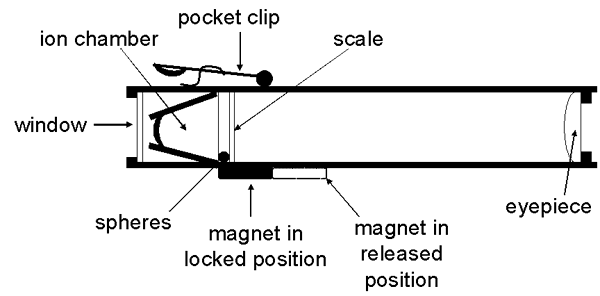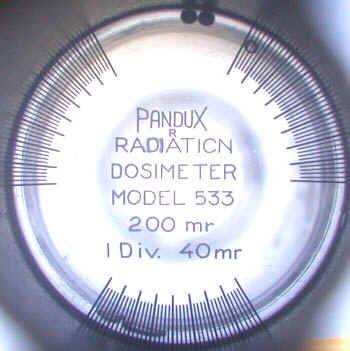Pandux Type 533 Dosimeter (ca. 1958-1960)
The Type 533 “Pandux” dosimeter was produced by Pacific Transducer (Pandux) Corporation of Los Angeles California—the company had previously been known as the Clarkstan Corporation. When viewed through the eyepiece, a circular scale is seen along with two spheres on the outside of the scale. The dose is estimated by measuring the rate at which the spheres move across the scale. To charge the dosimeter, the magnet (opposite the clip) must first be moved to the release position (towards the eyepiece). With the unit held vertically, the window end is rubbed back and forth on a horizontal flat surface at a rate of 150 to 200 cycles per minute. After one minute, the device should be fully charged and the two spheres should have separated by about five small divisions. At this point, the magnet should be moved to the locked position. When it is time to determine the exposure, the magnet is released and the position of the two spheres is recorded. A movement of one small division on the scale indicates an exposure of 40 mR.


The manufacturer stated "Accuracy is +/- 20% under all conditions. It can be discharged and charged again as often as needed, and no external charging equipment is required. It is completely tamper-proof and cannot be discharged except by ionizing radiation."

Gino Failla was the first to conceive the idea of determining a radiation exposure by measuring the rate at which charged spheres move together. His “Failla Cocktail” employed small plastic beads floating on the convex surface of water in a cocktail glass. When the beads were charged, they repelled each other and separated. As the “cocktail” was exposed to radiation, the charge on the beads decreased. This caused the beads to move together at the apex of the water surface. The rate at which they moved was a measure of the radiation exposure. His wife, Pat Failla, told me how her husband had dragged her along as he went from one toy store to another buying baby rattles so he could find the best beads for his cocktail.
In the photo to the left, the two spheres can be seen next to each other at the top of the scale.
References
- Nucleonics, October 1958, p 128.
- Pacific Transducer Instruction sheet, no date.
